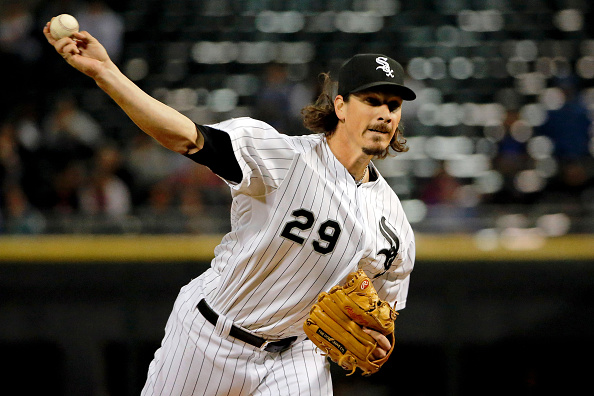Jeff Samardzjia is one of the top pitching free agents of this offseason and has been linked to many teams including the New York Yankees. The recent spike in revenues in Major League Baseball have pushed salaries to an all time high and top shelf starting pitchers are currently at the top of that list as witnessed by David Price’s 7 year, $217 million deal with the Boston Red Sox. The buzz on Samardzjia has led to projections that the 30 year old right hander may get as high as 5 years, $100 million.
Samardzjia has been a coveted entity since he broke into the majors with the Chicago Cubs in 2008. He wound up being traded to the Oakland A’s in a deadline deal during the 2014 season and was then shipped to the Chicago White Sox in the offseason. The question regarding Samardzjia has not been about his viability as a quality starting pitcher, but determining the market value for his services. Do the numbers support a $100 million contract? Let’s take a look.
Looking at players who are free agents generally involves a fascination with their last season of performance. The better the performance, the higher the fascination and a higher level of media and fan speculation. Teams also fall prey to this as they move in to acquire the latest, greatest thing. If looking at 2015 alone was the case in dealing with Samardzjia, I doubt many teams would be beating down his door looking to dump a load of cash at his feet.
In his first full year in the American League, Samardzjia led the AL in hits, home runs, and runs allowed. He started off slowly in the first half and things only spiraled out of control from there as he ended up with a 4.96 ERA on the season:
- 1st half: .714 OPS, 4.02 ERA, 4.43 SO/BB
- 2nd half: .835 OPS, 6.29 ERA, 2.35 SO/BB
Not the stuff a pitcher dreams of before going into a free agent season. But one bad year is not always cause for extra concern. A closer look at a 3 year average might give us a better look at his true ability and allow a projection to what the future may hold.
Samardzjia had an excellent 2014 campaign spent between the Cubs and A’s when he posted a 2.99 ERA and 1.065 WHIP with 202 strikeouts in 219.2 innings. Before the A’s were bounced from the playoffs in the wild card game, the thought was that he was on his way to becoming a top of the rotation pitcher. Then along came 2015.
Okay, so back to the original idea. A look at a 3 to 4 year average which essentially covers his entire body of work as a starting pitcher. His numbers in those years as a starter add up to an ERA of 4.14, a WHIP of 1.25, and a SO/BB of 8.2 in 846.1 innings pitched. Out of 96 starters over that time frame with a minimum of 500 innings pitched, he ranks 66th in ERA and 76th in WAR. He is 10th on that list in total innings pitched and has averaged 32 starts per season, so credit definitely has to be given for going to the post regularly and giving you innings, but a team shouldn’t pay a premium for that.
The pros of a guy like Samardzjia are that even though he will turn 31 in 2016, he has low mileage on his arm with only 1500 innings as a pro and he didn’t eclipse the 200 inning mark until 2013. While it is easy to be seduced by his fastball that has averaged a tick over 94 MPH, the fact remains that he been able to maintain that velocity consistently. So a lot of the red flags that might explain his downturn in 2015 and possibly beyond aren’t there.
Samardzjia played in front of one of the worst defenses in the majors last season with the White Sox, which was an exact opposite from what he experienced in his brief stint with the A’s. Another factor is that US Cellular Field is a hitter’s park and had the eighth highest home run rate in the majors last season. But guess what? Yankee Stadium is even more of a hitter’s park and had the fourth highest home run rate last season. Coming off of a season where his groundball rate dropped from 50% to 39% and his home run per fly ball rate skyrocketed does not give reason for much hope that a move to the Bronx would help other than the fact he would play in front of a much improved defense. Larry Rothschild has worked wonders with pitchers, but those are numbers that cause great concern.
Samardzjia is not a pitcher to shy away from. He is an innings eater and can keep you in ball games. Innings eaters get paid. Just not premium dollars. He also does not have any postseason experience save for a 2 inning stint in relief for the Cubs in 2008. And he also has a draft pick tied to his signing because the White Sox made him a qualifying offer after the season. If you put a great deal of stock inonly his 2015 numbers, a one year deal may seem appropriate. Given his body of work as a starter, 5 years and $50 million may seem right. $100 million??? Hard to justify. Of course, the Twins just gave Mike Pelphrey $16 million for two years.
The Yankees need to pass here. At least at this at what is thought to be the prevailing price point. They need pitching help and pitchers who gobble up innings at league average are always a plus, but the market is just going to push Samardzjia’s price too high for what he brings to the table. A reunion with the friendly confines of Wrigley Field would probably serve him well.




